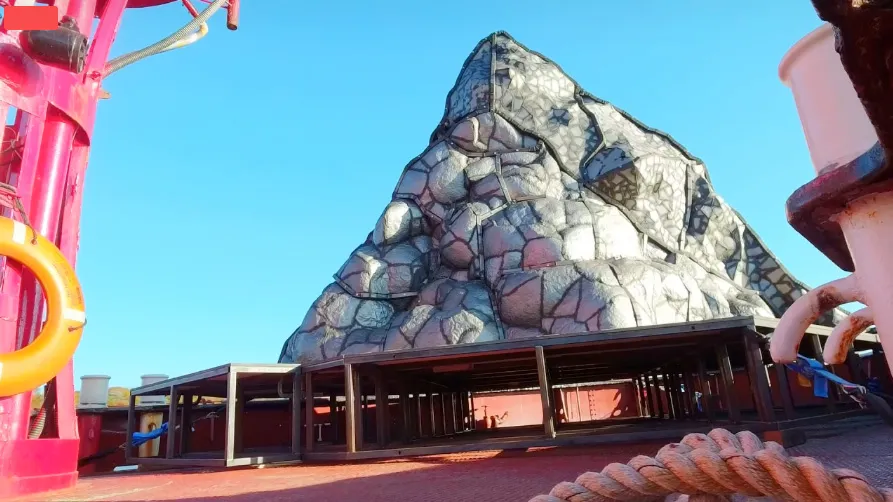
Ilopango, the Volcano that Left
What does it mean to recognize that sculptures, like continents and mountains, are on the move? Beatriz Cortez’s sculpture Ilopango, the Volcano that Left departs Storm King Art Center, the site of its current exhibition, to embark on a three-day performative journey along the Hudson River to EMPAC–Curtis R. Priem Experimental Media and Performing Arts Center. Onboard the fireboat John J. Harvey, the steel volcano travels north up the tidal estuary via Kingston to Troy to be installed in a concert hall for its second site of exhibition, leaving behind a sculptural footprint in its wake: an absence amidst other artworks on Museum Hill.
The volcano can be witnessed as it sails upriver from various viewing points on both shores and online through a livestream.
Members of the public are also invited to view it at the Hudson River Maritime Museum's riverfront Marina in Kingston on October 28, and to gather in welcoming the volcano when it passes through the Federal Lock and Dam near The Sanctuary for Independent Media in Troy on October 29.
A month prior to the journey, Cortez charts the conceptual content borne by notions of movement and impermanence for the Parsons Fine Art Visiting Artists Lecture co-organized by the Vera List Center at the New School.
In making this passage from a sculpture park to a performing arts center, Ilopango, the Volcano that Left proposes a line of questioning: What does it mean to consider sculpture as time-based? And can it become a performance? In (re)enacting a refusal to remain an object transfixed in a landscape, it exposes the fact that sculptures always already carry time, and are the ultimate records of their own making. When we encounter a sculpture as an artwork in an exhibition space, how might we apprehend the histories, geographies, and processes that are latent within it?
With Ilopango, the Volcano that Left, Cortez attends to a popular account of the Tierra Blanca Joven super eruption that took place in the mid-first millennium CE in what is now known as El Salvador. Imperceptible subterranean frequencies sounded before magma and rock were blasted thousands of miles into the stratosphere, reflecting light coming from the sun away from the earth to produce a yearlong winter that affected the ancient Maya civilization and regions beyond. Both geological feature and Indigenous deity, the volcano was dislocated from its site which was transformed into a large depression or caldera that is now the Ilopango Lake. As the volcano exploded into particles that dispersed in all directions, its ash was carried by the atmosphere to fall across the globe, and as far as Antarctica, where it can still be found embedded deep in the ice, a trace in the present or the continuing reverberation of a bygone weather event.
Centuries later, Cortez’s speculative sculpture performs both a reversal and an extension of this movement. Steel is a symbol of permanence but it is extracted from the earth. In building the volcano, the artist and her collaborators hand-beat out its industrialization, preparing the material for its return to its once organic state. Welded on the hill of Atelier Calder in Saché, France, the sculpture traversed the Atlantic Ocean to the artist’s studio in Los Angeles to be completed before making its way to the Hudson Valley, from where it will journey upriver to Troy and beyond. Cortez describes “the volcano that left” as an act of migration and considers its movements across land and water as a metaphor for the imperceivable yet continuous transformation of the landscape over time.
Its journey to EMPAC will be broadcast live by the presenting partners October 27 & 29. Filmmaker Guillermo Escalón and composer Igor de Gandarias will join the sculpture on its journey, recording the volcano’s passage for a forthcoming film (2024).
Video: Dr. Beth Harris and Dr. Steven Zucker, "Beatriz Cortez, Ilopango, The Volcano That Left," in Smarthistory.
In this September 20, 2023 talk at the Vera List Center, EMPAC-commissioned artist Beatriz Cortez charts the different ways in which her monumental sculpture Ilopango, the Volcano that Left counters ideas about permanence, portals, and multiple temporalities.
Dates + Tickets
EMPAC Fall 2023
Press Mention
Season
The volcano’s journey is presented in partnership with Storm King Art Center and the Vera List Center for Art and Politics at The New School, and will feature a weekend of collaborative programming along the Hudson River.
Ilopango, the Volcano that Left by Beatriz Cortez is co-commissioned by EMPAC–Curtis R. Priem Experimental Media and Performing Arts Center at Rensselaer Polytechnic Institute, Storm King Art Center, and the Vera List Center for Art and Politics at the New School. The sculpture was created in part while Cortez was in residence at Atelier Calder, Saché, France.
The sculpture’s journey along the Hudson River and its documentation for the forthcoming film by Guillermo Escalón are made possible with major support from Teiger Foundation, and with project support from the Simons Foundation, and also by New York State Council on the Arts with the support of the Governor and the New York State Legislature. Additional program support is provided through the artist's Borderlands Fellowship at the Vera List Center for Art and Politics at The New School.





